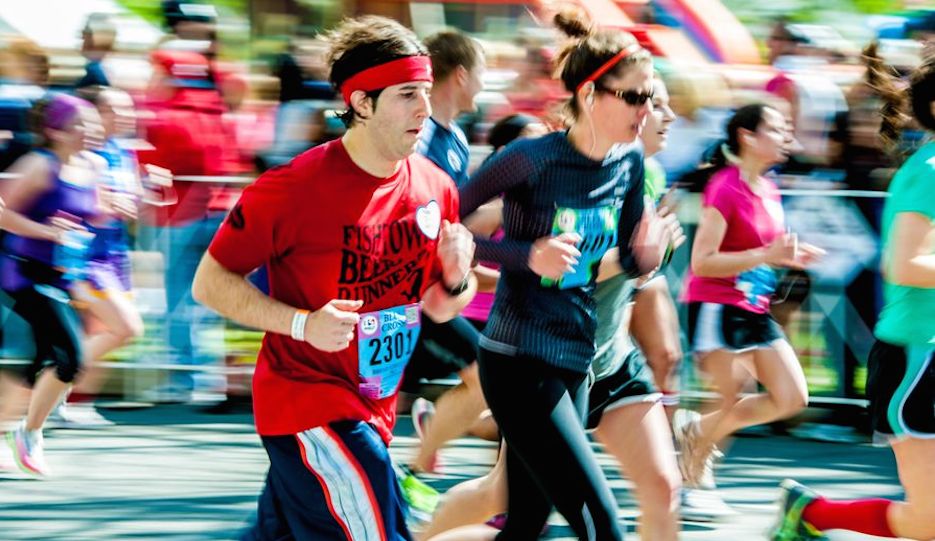What to Eat (and What to Avoid) Before and After the Broad Street Run

Photo by Jeff Fusco
After months and months of grueling training for the Broad Street Run, ruining race day by eating foods that set you up for physical discomfort would be the absolute worst, right? So, to make sure you don’t do that, we chatted with registered dietitian Angie Asche of Eleat Sports Nutrition to get the scoop on what your plate should look like before Broad Street — including the night before the race and race-day morning — along with what types of foods to avoid. Because, real talk: The last way you want to spend race day is holed up in a porta potty.
What to eat the night before the race …
Say it with me, friends: fruits, veggies, whole grains, lean protein and unsaturated fats. Those are the key items to have on your plate the night before the race (and the days leading up to the race). Asche says your plate should look like a mix of about 50 to 60 percent carbohydrates — think: fruits and veggies like bananas, sweet potatoes, dates, spinach, oranges and berries, and whole grains like quinoa, brown rice and oatmeal — and around 40 to 50 percent a mix of lean protein and healthy unsaturated fats like nut butters, pumpkin seeds, avocado, and so on.
When it comes to the emphasis on fruits and veggies, Asche explains, they’re rich in antioxidants which help to prevent inflammation and injury, plus they’re a good source of carbohydrates, which replenish glycogen stores, assisting in the recovery process.
Asche’s idea of an ideal pre-race dinner, that covers all the bases mentioned above, is a 4-ounce lean turkey burger in between two slices of whole-wheat bread, with a side of roasted sweet potatoes drizzled with around two tablespoons of olive oil. But — and this is a BIG but — Asche urges runners not to try anything new the night before or the morning of the race. The last thing you want to do is eat something that screws with your digestion. So if turkey burgers aren’t in regular rotation on your dinner table, opt for a combo of carbs, lean protein, and healthy unsaturated fats that you’re used to.
And if you’re wondering why you aren’t seeing any carb-loading, “Eat ALL the pasta!” talk here, that’s because Asche says carb-loading isn’t really necessary for a 10-mile run. In fact, while Asche does suggest having some grains the night before the race, she says overdoing it on simple carbs — i.e. attending a pasta party — the night before the big day could cause more harm than good, as “eating too much the night before could lead to bloating and gastrointestinal distress during your race.” No, thank you. She also notes that most people don’t really understand what carb-loading — a weeks-long process — actually is, but that’s another conversation. When it comes to foods to avoid leading up to the race, trans fats, saturated fats, refined sugar and refined white flour all make the list.
What to eat the morning of the race …
Again, this is not the time to decide you want to get your Julia Child on and whip up a feast of foods you’ve never tried before. Asche suggests reaching for something you’re used to, and steering clear of foods high in fiber and fat, which can be hard on your digestive system. (Dr. Meyer also touched on this when we asked her the very important question: Why does running make you poop?)
Asche’s suggestion for a pre-race meal is a slice of bread with a small smear of peanut or almond butter — key words: small smear — and a big banana. When it comes to coffee, Asche says if you’re used to running after downing java, go for it — just try to keep your caffeine intake under 300 milligrams. Going over that can up your risk of dehydration.
What to eat after the race …
While you might feel more like collapsing on the ground and staying there for awhile than eating after the race, Asche suggests getting some carbohydrates and protein — which, again, assist in recovery and protect muscles — into you as quickly as possible. Ideally, you’d have a plate filled with a 3:1 ratio of carbs to protein. If nothing else, she says to at least try to stuff a piece of fruit into your mouth within 30 minutes of finishing the race.
And there you have it: Asche’s pro tips for how to fill up your plate before and after the Broad Street Run. Now, when it comes to during, Asche says that if it will take you more than 90 minutes to get through the race, you’ll probably want to plan on getting some form of carbs during, like a sip of a sports drink or sports gels. But again, don’t you dare try anything new on race day. So now that you know what you should be filling your plates with, go get your Trader Joe’s shopping on before the post-work line gets totally bonkers.
Like what you’re reading? Stay in touch with Be Well Philly — here’s how:
- Like Be Well Philly on Facebook
- Follow Be Well Philly on Twitter
- Follow Be Well Philly on Pinterest
- Get the Be Well Philly Newsletter


